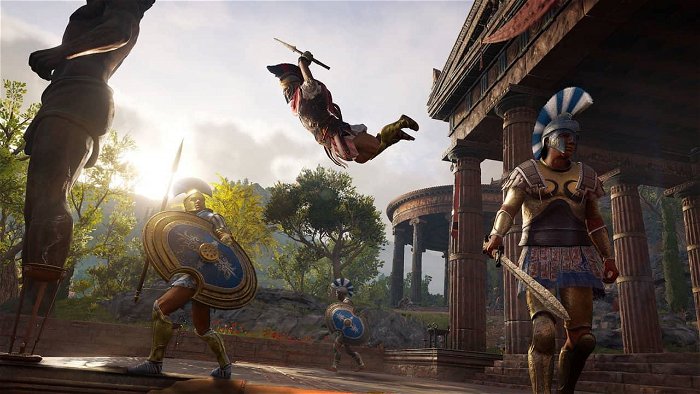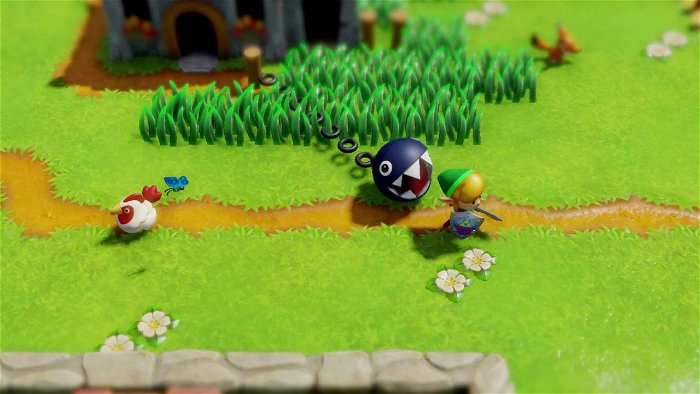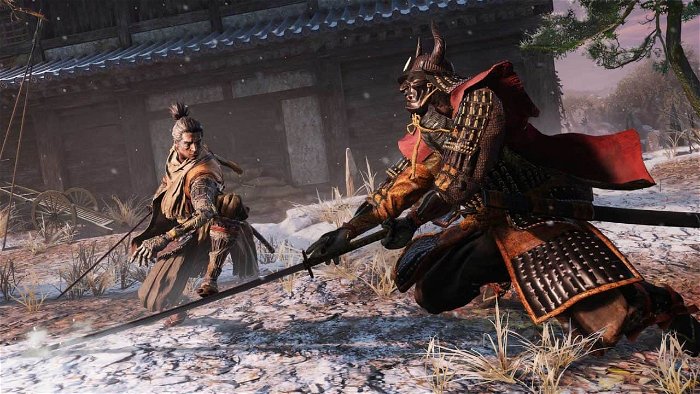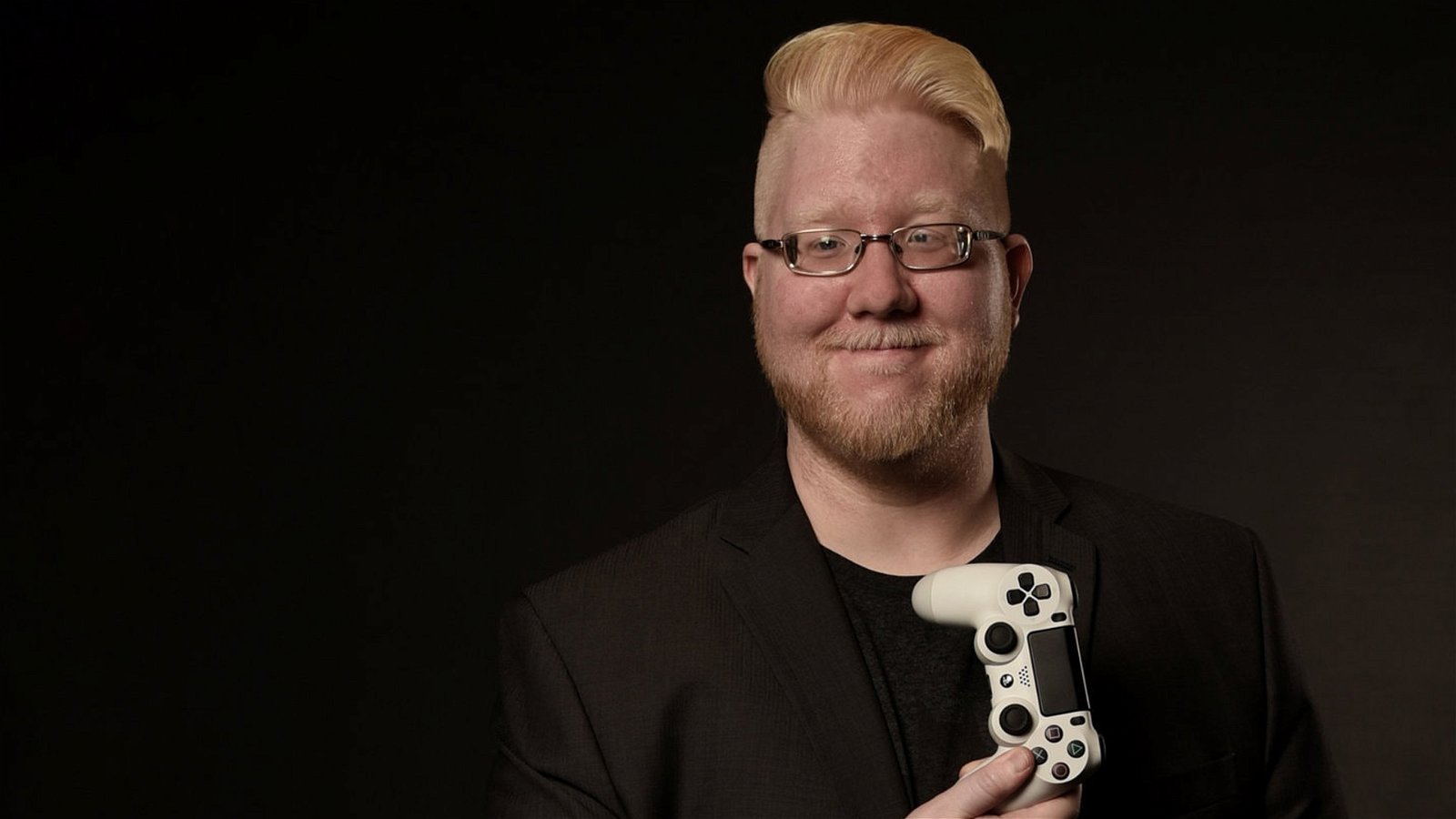There are two types of gamers excited to jump into a brand new game.
One comes as players speed through its main menu to start the first cutscene that plays. Others take a few extra minutes to scan through the options to see what additional goodies can be turned on, changing the gameplay experience for better or worse. Of course, classic settings from camera sensitivity to control schemes make or break immersion and comfort. Others such as subtitles and text size can help players appreciate the level of script writing that comes in today’s heavy cinematic narratives.
For Canadian Game Award nominee and content creator Steve Saylor, every setting can decide whether or not he’s able to enjoy the next major release. With a condition called nystagmus, Saylor is legally blind as he navigates through countless game worlds with uncontrolled eye movements. Despite the trait, Saylor presents his Let’s Play videos in ways which highlight accessibility in today’s games.
Saylor has also kept a steady flow of playthroughs online since 2015, profiling games such as Resident Evil 3 Remake, The Outer Worlds, Star Wars: Jedi Fallen Order and 2018’s God of War for audiences. Quick-time events, button responses and snap decisions in games are what he describes as part of a natural humor seen in Let’s Play videos – with added commentary on the state of accessibility from developers to make AAA releases fit for everybody. His conversations also lead him to become a consultant for studios including Electronic Arts and Ubisoft, all within reach from their Canadian studios as they added specific settings in menus during development.
Originally on the nominations committee for this year’s revival of the (postponed) Canadian Game Awards, Saylor became a part of something that recognizes the North’s own contributions in one of the world’s biggest entertainment mediums. As the votes were decided, Saylor’s role for the awards changed when he became a nominee himself, at the blessings of his own peers.
The awards were finally hosted on September 18, 2020 as Saylor continued to advocate for accessibility and became involved in Naughty Dog’s flagship game The Last of Us Part Two. Though the award for content creator went to Vancouverite DangerouslyFunny, Steve expressed his support and looked back at his past 12 months:
I’m extremely happy Dangerously Funny received the award. It was rightfully deserved and they produce amazing content. As amazing as the nomination was it truly was an honour to be nominated. It also allowed me to think about the difference 2019 and 2020 was for me. As amazing as 2019 was, it was amazing to look back at that through the lens of the Canadian Game Awards and see how far I’ve come in a short period of time. I’m very grateful for the support everyone has given me this past two years and I can’t wait to see what’s to come.
Steve Saylor (BlindGamerSteve), Canadian Content Creator and Game Accessibility Advocate
Interviewed ahead of the first annual awards ceremony in March 2020, CGMagazine sat remotely with Saylor, who shared his own awards twist and how it reflects the global conversation for accessibility – an accountability being pushed forward in game studios today.
CGMagazine: Curiously, what were you up to when you found out about your nomination?
Steve Saylor: So, funny enough, full 100% disclosure, I was on the selection committee for the Canadian Game Awards, but when it came to the content creator side of things I had completely abstained from it. And I basically didn’t nominate and I didn’t sort of provide any nominations. I felt like because I’m a content creator, I should be at least abstained from that and when I found out that I was going to be nominated, it was actually on a conference call about it.
And apparently other people within the selection committee had nominated me in there, and I found out when I got the list of the narrowed-down nominees, and I was the first one. I was like, oh, okay, so basically the entire call. I was silently just like, feeling really nervous and excited, but trying to be professional and not say anything during the whole call. So once I got off the call, I was just basically jumping up and down in my office with excitement.
So when I finally kind of went up online, it just it that’s when it sunk – like really fully – hit. And it was so weird to see my name up there with so many amazing people and I think that’s when it started to hit home. I’ve been kind of on this sort of weird cloud nine since then.
CGMagazine: As someone who’s in the nomination committee, did the nomination check a lot of the boxes that had to be considered?
Steve Saylor: I believe so. Because the way I sort of saw it with the selection committee and the Canadian Game Awards is that we really wanted to celebrate, just Canadians making video games. That’s kind of what we boiled down to and we wanted to celebrate those who put in the amount of work to basically put Canada on the map as it were in the video game industry. And we have such amazing talent in this country, that I feel like it a hundred percent of it should be celebrated. And when it comes to content creation, I fully believe it’s that: yes, you making content about video games and being Canadian is definitely a category in there. But I feel like a nominee should be proud to be Canadian and also, hopefully is making an impact in the in the video game industry in some way, shape or form. I fully understand and know that I’m one of, if not the smallest, creator on that nominations list. And I so I feel like that each one of us has sort of made an impact in the in the video game industry in our own separate way.
CGMagazine: What are some of the ways that you bring accessibility into your content?
Steve Saylor: It’s interesting because when I first started out with my channel, with my show Blind Gamer, originally it was it was kind of a way to entertain my friends. I basically kept telling them for years: “Well, like I like I’ve been telling you that I suck at video games. here’s proof. And I’ve heard for years I basically touted the fact that’s like ‘okay, you want to see how it like how bad I am a video games? Watch this,'” And it started off as being just sort of a thing that basically to be like a Markiplier or PewDiePie kind of thing.
It was when people started to ask me about accessibility and what is it like, what kind of a vision do I have. What would I like to see within video games to help make video games easier for me, or have few less barriers for me to be able to play? I basically kind of within the past few years shifted my focus and that instead of being just a player, I wanted to be able to promote accessibility as best I can and also provide information for those who are disabled that are not sure if a game is right for them. Or, if there’s any settings that could be able to help them in playing a game. So, that’s where I kind of focused a lot of my content in, essentially to promote and be an advocate for accessibility and hopefully show video games that are doing it well
CGMagazine: How is the Canadian Content landscape shaping up compared to other parts of the world?
Steve Saylor: Well I feel that the Canadian video game industry is very strong here and I feel that the as however you feel about sort of the Canadian Governments as they sort of changed over time, obviously they’re very, very interested in wanting to build in the arts. And I feel like that the video game is definitely a pretty awesome art form. And Canadians are definitely are creative and talented. And there’s a there’s an amazing video game industry like even just on the indie side, like here in Toronto, I’ve said it for years, essentially, is that it’s sort of the Silicon Valley of indie games. There’s so many amazing studios that are here in the city.
So I think that in regards to the Canadian industry, it’s like, some people I think, would probably be surprised at just how many of their favorite games are Canadian. Ubisoft being kind of the one sort of out-front-and-center with its Montreal studio, but also their Toronto studio. There’s also The Coalition who made Gears 5. Obviously we have Bioware, regardless of how you feel about what they put out last year, I still think that they can be an amazing studio just with the work that they put out in its past. But then we’ve also got indie studios like DrinkBox. And we also have Matt Makes Games when he made I believe he was the one who made Celeste I’m not mistaken. But yeah, it’s really cool to be able to see the Canadian game industry being able to sort of receive recognition in this way. And I know that the Canadian Game Awards has been in the past and I’m glad that’s being resurrected.
CGMagazine: And while you mentioned Canada could be the Silicon Valley of developing video games, what does that mean for (developing) accessibility in games?
Steve Saylor: I hope that means more studios would be open to building accessibility. Obviously it’s kind of a very weird time at the moment. So, it’d be interesting to see moving forward, whether or not studios will be open to being able to talk to those who are in the accessibility community to be able to help them make their games. It’s normally done in the past where essentially, they would hire a consultant to fly into other studios and talk with them about what it means: what accessibility options would be beneficial for them. But now maybe with the way it is now that if they’d be open to bring you to the basic vehicle in virtually and being able to talk with them within their own home, we’ll see how that goes. But I really hope that more studios, not just in Canada, but just globally that I applaud any studio that’s able to bring in people from this community to help make their games more accessible. So I just would love to be able to see, hopefully, maybe Canada kind of take take full advantage of that. Ubisoft has definitely already started. So would love to see other developers, indie developers do the same.
CGMagazine: How do the developments of accessibility in games affect the way that you present your content to people online?
Steve Saylor: It’s interesting. Yeah, because generally, when it comes to sort of information about accessibility in games, it’s kind of rare to see studios putting that information forward. Especially to be able to help sample players who’ve been able to make the purchasing decisions to pick up any of their games and I see that it’s sort of lacking. I know that some studios have put out their accessibility information in the past like Ubisoft has done, so Square Enix has done that as well. But I feel like where I sort of fit in is that I would love to see that information being put forward in the video game media so that way, showing off settings – and the settings within games – are showing what accessibility options games have.

CGMagazine: Could you walk me through some of the games that you found to be super accessible and friendly during your whole career streaming in recent memory?
Steve Saylor: I would say that the ones that I’ve I found to be most accessible – the one actually that really comes to mind is from an indie studio that actually is Canadian, they’re from Toronto. It’s a studio called Household Games, and they made a game called Way of the Passive Fist. And it’s sort of like an old school 16-bit style fighting game kind of in the Super Nintendo kind of era, but the whole premise of it is that you, you’re pacifist, and you don’t like fighting, but you can even dodge every single attack that comes against you. And so the point where they the enemies get so tired that you just hit them with one punch, and then they go down. And they really took the time to add a lot of accessibility into it. They have a lot of accessibility for deaf and hard of hearing, for visual disabilities, for motor disabilities. and for cognitive disability, so there’s a lot that’s that’s in there.

Other games that kind of come to mind that are not as fully as accessible, that actually not every game could be 100% accessible, but I’d love to be able to preach features and options that the games to the studio do have. So Assassin’s Creed Origins and Odyssey just in regard to their subtitles options alone we’re revolutionary and kind of extremely well phrased for not only just having it in there but having it turned on by default. And they actually had come out and said that over 90% of the people who had started playing the game for the first time, didn’t turn subtitles off and they kept it on. So that’s a huge bonus for, for accessibility in that regard. Uncharted 4 was also a really pioneering game for accessibility and the fact that before even starting the game, there was an accessibility menu that popped up before even starting that allows you to customize your play style, so that there’ll be less barriers to play.
Gears 5, also made by a Canadian company, The Coalition, they put a lot of effort into their accessibility and was the first game to be able to receive a basically a perfect score on Can I Play That? for its Deaf and Hard of Hearing accessibility, and that’s kind of the first time that that’s ever happened on at least from my understanding from a review standpoint. So those are the games that kind of come to mind that I’ve been very happy to see and promote for accessibility.

CGMagazine: And in putting these games into your videos to walk through it in recent memory, could you talk about some of the videos which changed the style of your content that’s shown today?
Steve Saylor: As of this year, I made a concerted effort to actually change the way I sort of create content because before I’ve done mostly just Let’s Play videos. And sometimes I talked about accessibility in other separate videos. But mostly when I play a game, it’s usually just to kind of sort of show firsthand what playing a game is like, if you have a visual disability. And I was faced I was always a fan of like, people like Markiplier and PewDiePie. For that, and I but I felt like that, that was kind of my niche and sort of like being a disabled player. That’s sort of an interesting thing to build to watch. But then when I realized essentially going back to what I said before about how studios and sites are not really giving out what is the information of what accessibility options are available before game has come out. There was one example of I received a review copy of Star Wars: Jedi Fallen Order from last year, and went around this time, I was sort of thinking about kind of how my content was going to be for this game, and I thought I could just do sort of a regular let’s play of it. And I did do that. But one thing that sort of started taken off was what I did a video where I showcased the settings and accessibility options. And I sort of explained and educated what these accessibility options mean for disabled players that hopefully, this can help them.
CGMagazine: And with that in mind for the awards, which were some of the videos recently that you think set the nomination?
Steve Saylor: I think definitely, like I said, the Star Wars one for sure was a was definitely a big impact.
I also did a series where I was really proud of where I played a Legend of Zelda: A Link to the Past for the first time. And I know how beloved that game is. And I was very excited to be able to play for the first time and so I played it on the Super Nintendo Online on the Nintendo Switch when they released it. And I started playing it and I was out, have fun, and it was doing pretty well. But I think the most proudest I was when it was starting to get really difficult for me to be able to play. I was getting frustrated with it, and I didn’t and I had to sort of make a decision of: do I try to build a force myself to keep going so that I can build a play through the entire game, or do I just like stop and just don’t like don’t finish?

Or do I put out a video sort of explaining why I can’t play this anymore, and I was scared to do this. I decided to do the latter, and I was scared to put that out. I didn’t know how that was going to be received. But then when it became kind of one of the, one of the videos last year, that I was very happy that I was able to be a little bit vulnerable in that sense and really kind of showcase how important accessibility is and how it could be for player. Even though it was tough, and I felt bad about not playing the game, I did feel that it was important for me to be able to show: if you have accessibility, it can it can make the difference when you’re trying to be able to play a game.
When Sekiro: Shadows Die Twice came out, I put out a video where I talked about an article from Forbes that came out that said ‘Sekiro, you need an easy mode.’ And there was a lot of debate online if that’s the case, because a lot of people said that game was meant to be hard, those games from From Software was meant to be played at a really hard difficulty. But for those in the accessibility community, we felt that that could have been an opening for players with disabilities to be able to jump into that world and enjoy the game as as it did.
And we totally understand that one: obviously it won The Game Award for Best Game of the Year last year, but for a lot of players, it kind of shut out. We kind of felt like it was just we weren’t able to play the same games our friends were playing. So I did a video where I talked about that, and that definitely was one that sort of stood out from last year.

CGMagazine: And of course, I wanted to ask as well, out of all the hurdles leading up to the awards, which would you say in recent memory was the biggest one?
Steve Saylor: last year was definitely a learning period for me. It was where I really kind of where I doubled down on accessibility, because essentially being an accessibility advocate and consultant is my second career. I’ve worked in the radio industry and in broadcasting for a good, large chunk of my life. So this is something that’s brand new to me.
And I’d say the hurdle was just was trying to build to stay positive in that sort of sense when, even especially with Sekiro last year, kind of being a major issue. And for some of us, we received some death threats and we received some pretty nasty comments from trolls and just from negative people online. And that was a major hurdle because we were in the public eye in that sense. It was hard. And I think just the hurdle I had was just persevering and realizing that I’m that myself and the other content creators in the accessibility community, we wanted to push forward was that is positivity and education, instead of confrontation.
CGMagazine: And depending on the outcome of the awards, of course, anything can happen. Ahead of your nomination, what does the award mean to you personally?
Steve Saylor: Personally, I am very humbled and and honored and blessed to be in this position and this award is completely unexpected. I wasn’t in this and a lot of people probably say are we’re not in this to be able to make awards. For me personally, I just wanted to promote accessibility and as being human, of course, I love the accolades of winning an award if that’s possible. Sure. But for me, this is something that I’ve been passionate about for five years, and I’ve been making content for even longer to make content for 15 years now and I’m seeing this as a as a combination and a celebration of that. This is a huge honor. And it’s a huge honor to be nominated amongst several amazing content creators.
Canada has some great content creators and that should be nominated right alongside me and I hope that those who weren’t nominated this year will and in the future, and those who are nominated will feel the same way. Yeah, just I’m very humbled that, I know I’m one of the smallest creators in that nominated list. But to be an esteemed company is a huge, huge honor even of itself and you hear all the time of people saying it’s an honor to be nominated, but now I truly understand what that means. And 100% definitely it’s an honor. And even if for whatever reason I don’t win, being a Canadian Game Award nominated content creator, still a pretty nice accolade to have and so I’d love to go to change that from nominated to award winner but we’ll see what happens for sure.
CGMagazine: Do you still remember the first time you touched a controller and played a game?
Steve Saylor: Yeah, for sure. I grew up in the generation when the very first Nintendo came out. I remember my mom was with my brother and I, we went to a local video store. She purchased the original Nintendo system as a gift for my dad for Father’s Day. That was what she said. And actually, it was so new to us that we didn’t even know that it came with a game, that it came with Super Mario Bros. and Duck Hunt. So we actually bought a separate game and it was The Three Stooges for the NES. And my mom brought it home and we gave it to a my dad, but he never really played it.
So I think it was sort of like a slick way that basically for my mom to kind of purchase something to justify something for my brother and I. And I remember playing Super Mario for the very first time. And at first it’s like, it’s like I thought I actually sucked at video games, because I wasn’t really that great at it. So I let my brother play more than than I did. But I did feel like I sort of in a way, was able to enjoy the experience along with him because I was able to watch him play. This is that’s how I fell in love with the Let’s Plays genre because it felt like it was exactly how it was when I was a kid, and I was playing video games and watching my brother play. Yeah, it was a pretty surreal experience to to be able to put in that cartridge and blow on it when I needed to make sure it works and turn that on and just in being able to jump into a different world altogether was was really cool.

I fondly remember that I actually to this day. Actually, it was funny. My mom played Nintendo too and she didn’t she still wasn’t anything to this day because once she found Monopoly on the NES, it’s kind of the last game she ever really played. But I remember she beat Super Mario before my brother and I did. We still think to this day, that she would have been a much bigger gamer than I would have. But it was still cool. Like I remember we would pass the controller between the three of us back and forth as we were playing Super Mario and it was one of my fondest memories for sure.
Saylor was nominated for Best Content Creator/Show as part of the first annual revival of the Canadian Game Awards by eSports organization Northern Arena.
Since March 25, 2020, the ceremony was postponed due to the worldwide COVID-19 pandemic and revealed their winners on September 18, 2020.
More details can be viewed on their official website here.




